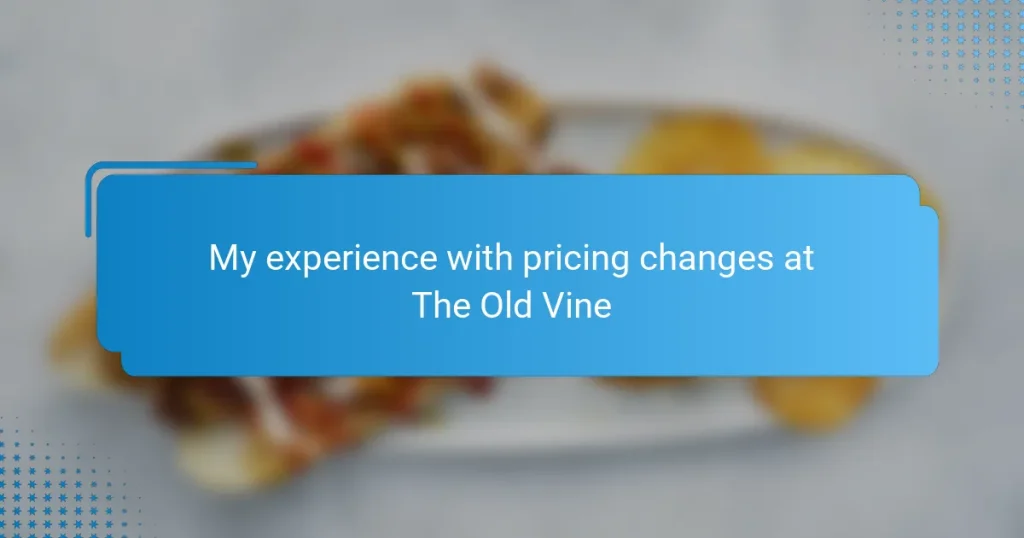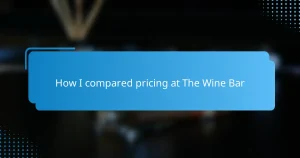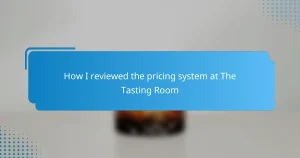Key takeaways
- Wine bar pricing at places like The Old Vine reflects various factors, including supply, rarity, and market trends, which enhances customer experience.
- The ambiance, curated selection, and knowledgeable staff contribute to a memorable experience, justifying the mid-to-upper price range compared to other local wine bars.
- Price adjustments can encourage exploration of new wines and deepen appreciation for the selection available, turning potential frustration into positive engagement.
- Patrons can adapt to price changes by being open to new experiences, timing visits for potential deals, and engaging with staff for insights and recommendations.
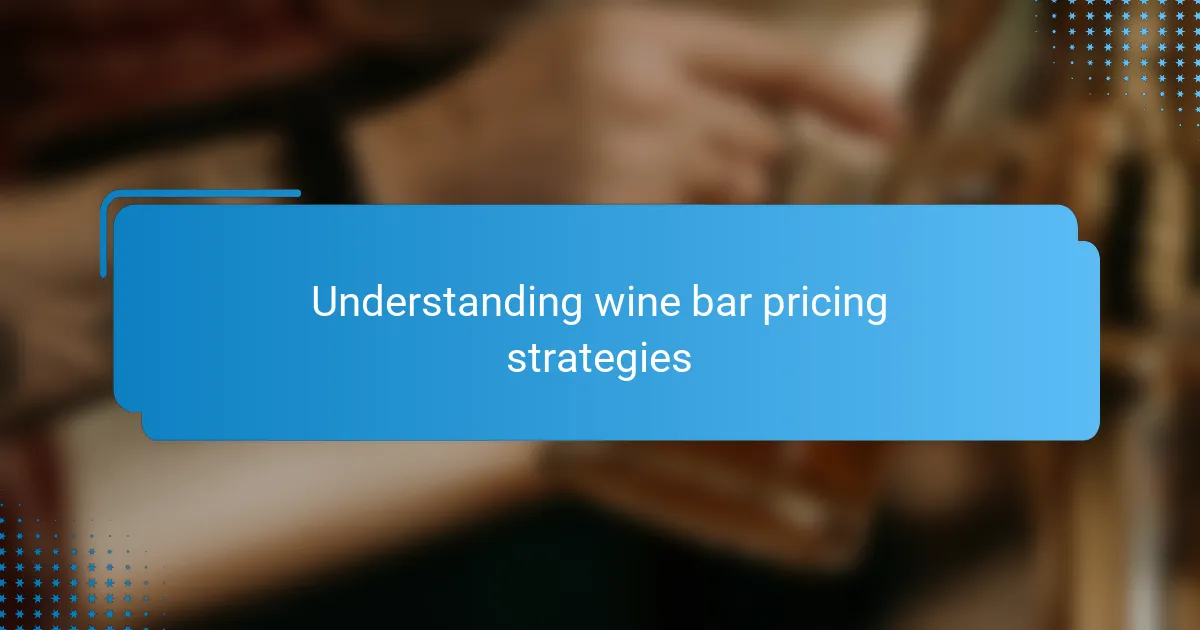
Understanding wine bar pricing strategies
When I first noticed the price shifts at The Old Vine, I wondered if it was just supply and demand or something more nuanced. Wine bar pricing often reflects not only the cost of the bottles but also the experience offered—ambiance, service, and even the selection’s rarity. Have you ever paused to think about why a glass of Pinot Noir might suddenly cost a bit more one evening than another?
From my experience, these pricing strategies aren’t random. They can be influenced by special events, seasonal availability, or even attempts to attract different customer moods—like encouraging a casual weekday crowd versus a weekend celebration vibe. I’ve found that understanding this makes the price changes feel less like a surprise and more like a part of the whole wine bar story.
It’s interesting how pricing can also signal quality and exclusivity. When The Old Vine raised prices on some premium wines, it made me curious about what changed—was it the vintage, the supplier, or just a shift in market trends? This awareness helped me appreciate the thought behind each price tag, turning what could seem like a frustration into a conversation starter with the staff.
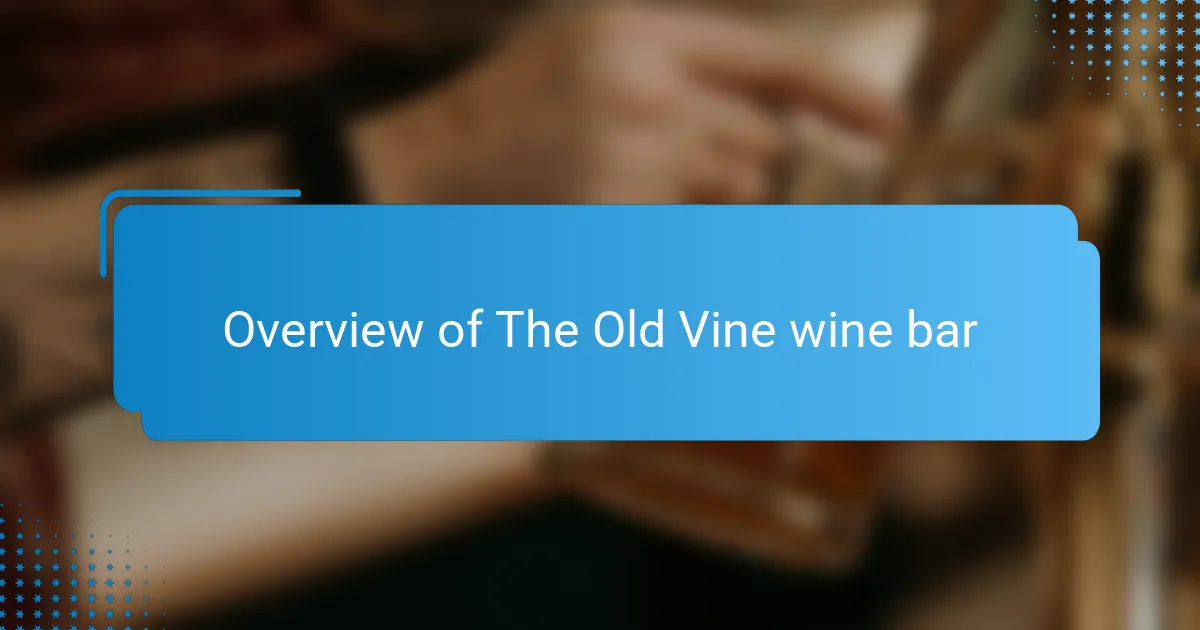
Overview of The Old Vine wine bar
The Old Vine has always struck me as more than just a place to sip wine—it feels like a cozy retreat where each bottle tells a story. Its rustic decor and soft lighting create an inviting atmosphere that makes you want to linger, glass in hand. Have you ever walked into a place and immediately felt at ease? That’s exactly what The Old Vine does.
What I really appreciate about this wine bar is its thoughtfully curated selection. From familiar favorites to rare finds, the menu seems designed to satisfy both casual sippers and seasoned connoisseurs. I remember discovering a local blend here that I hadn’t seen elsewhere, which made the experience feel special and personal.
Of course, great service ties it all together. The staff at The Old Vine know their wines inside out and are always eager to share stories or recommend something off the beaten path. It’s that genuine passion that, in my opinion, elevates this spot from just another wine bar to a memorable destination.
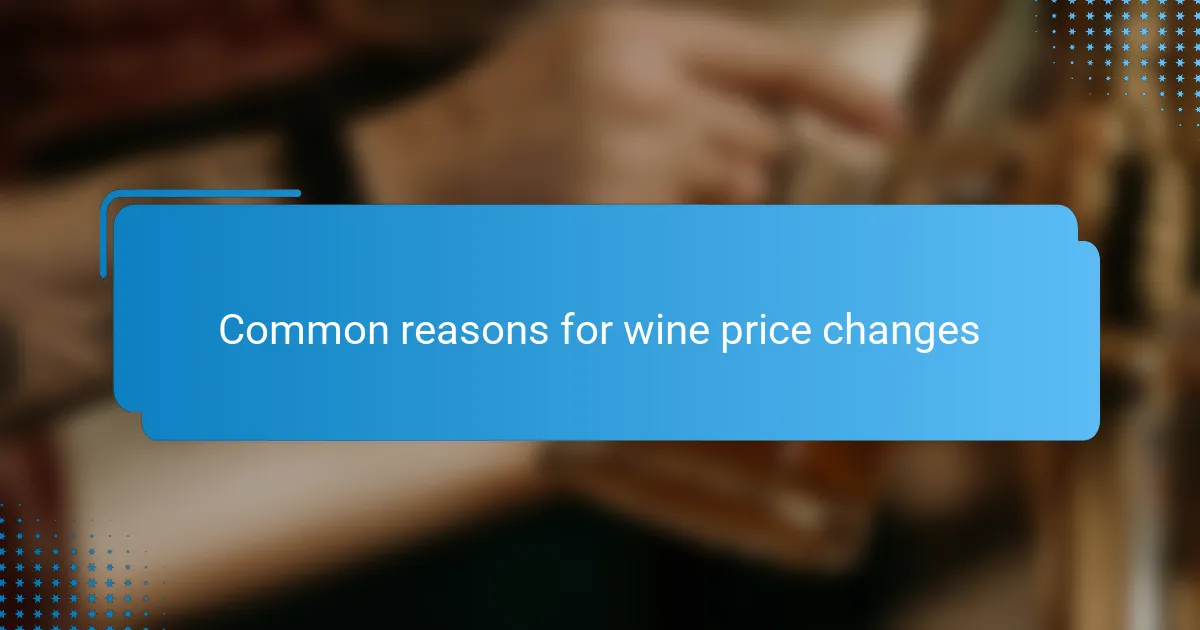
Common reasons for wine price changes
One common reason I’ve noticed for wine price changes is fluctuations in supply. For instance, when a certain vintage crop experiences a poor harvest, bottles become scarcer, and naturally, the cost goes up. Have you ever seen your favorite wine suddenly cost more and wondered if it was just a coincidence? More often than not, it reflects real changes in availability.
Another factor that seems to play a role is the influence of external costs like shipping and taxes. I recall a night at The Old Vine when the sommelier mentioned that recent import tariffs had pushed up prices on some European wines. It made perfect sense to me then why those familiar bottles were suddenly a bit pricier, even though everything else about the bar felt the same.
Finally, promotional strategies affect pricing more than we might realize. Sometimes prices dip during quieter periods to encourage patrons to try new selections or come in earlier. I often find myself tempted by these temporary deals, which also show how pricing is used to shape the whole wine bar experience—not just cover costs.
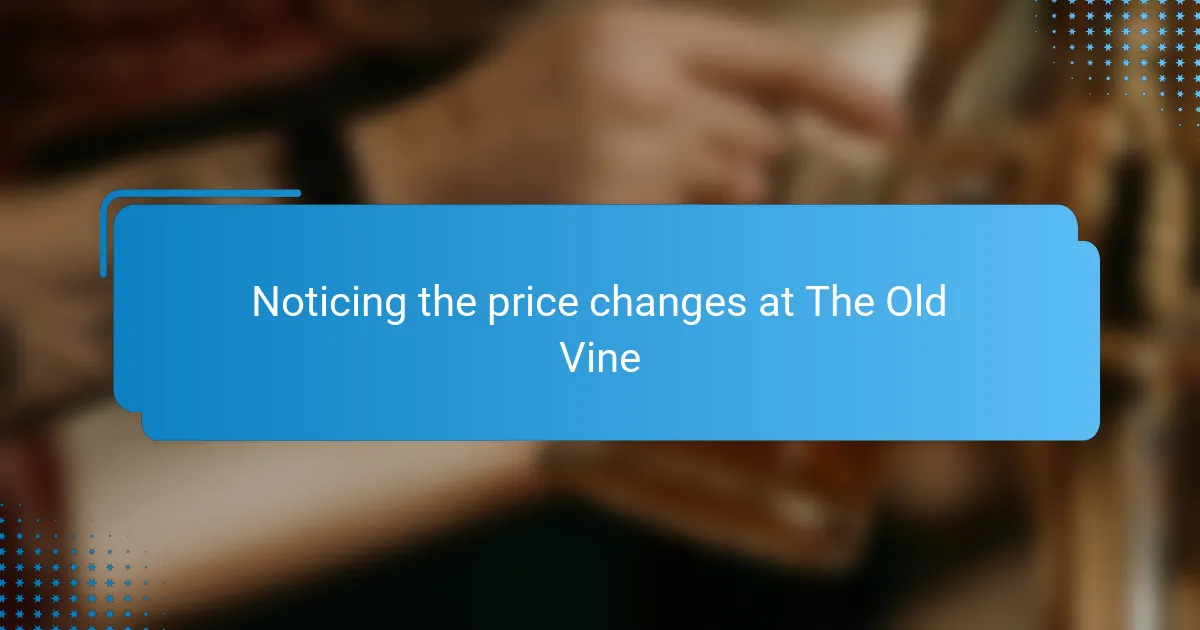
Noticing the price changes at The Old Vine
I first noticed the subtle price changes at The Old Vine during a weekday visit that felt a bit quieter than usual. It caught me off guard—was I imagining it, or had the glass of Malbec really crept up a couple of dollars? That moment made me pause and realize how sensitive pricing can be, even in such a familiar setting.
There was also a time when a new, limited-edition wine appeared on the menu, and its price was noticeably higher than similar options. I remember asking the bartender about it, curious if it was just hype or if the quality truly justified the jump. Their explanation about rarity and the vineyard’s story added a whole new layer of appreciation for that price tag.
Have you ever felt a mix of surprise and curiosity when seeing prices shift where you usually spend? That’s exactly what happened to me at The Old Vine, transforming what could be frustration into an invitation to learn more about the wine and the bar’s evolving story.

Impact of price changes on my visit experience
The price changes at The Old Vine definitely influenced my overall visit vibe. When my usual favorite suddenly cost a bit more, I hesitated for a moment—was I willing to pay extra just for the same experience? That little pause made me more aware of how price tags shape my choices and mood during the evening.
Interestingly, the higher prices on select bottles pushed me to explore new options I might have overlooked otherwise. It was like the bar was nudging me out of my comfort zone, which surprisingly added a fresh excitement to the visit. Have you ever found that a price shift encourages you to try something unexpected? That’s exactly what happened to me here.
Of course, there were moments when the increased cost felt a bit discouraging, especially on a casual weeknight. Yet, knowing the reasons behind those changes—rarity, quality, or special events—helped me appreciate the experience rather than feel put off. It made me realize that pricing isn’t just about numbers; it’s part of the story the bar wants to tell each time you walk in.
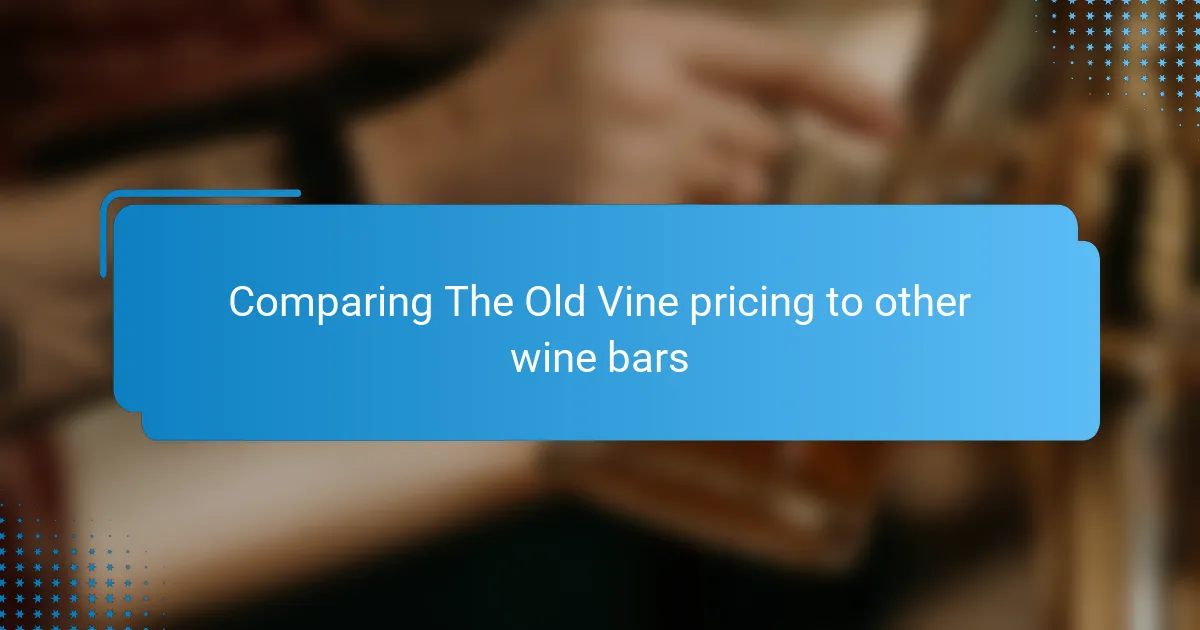
Comparing The Old Vine pricing to other wine bars
When I compared The Old Vine’s pricing to other wine bars in town, I noticed it sits somewhere in the mid-to-upper range. It’s not the cheapest spot to grab a glass, but given the thoughtful curation and cozy atmosphere, the prices felt fair to me. Have you ever paid a bit more somewhere and felt it was justified by the overall vibe and service? That was exactly my experience here.
Interestingly, some other local wine bars lean heavily on lower prices as their main draw, but I found that often meant compromising on the selection or service quality. At The Old Vine, the slightly higher prices seemed to reflect a commitment to specialty bottles and knowledgeable staff, which I personally value. It made me think about what I’m really paying for—the experience, not just the drink.
Of course, there are premium wine bars where prices can be noticeably higher, sometimes double what The Old Vine charges. For me, those places often feel more formal or even intimidating, which isn’t always what I want on a casual night out. So, in balancing price with comfort and quality, The Old Vine has hit what feels like a sweet spot that matches my style perfectly.
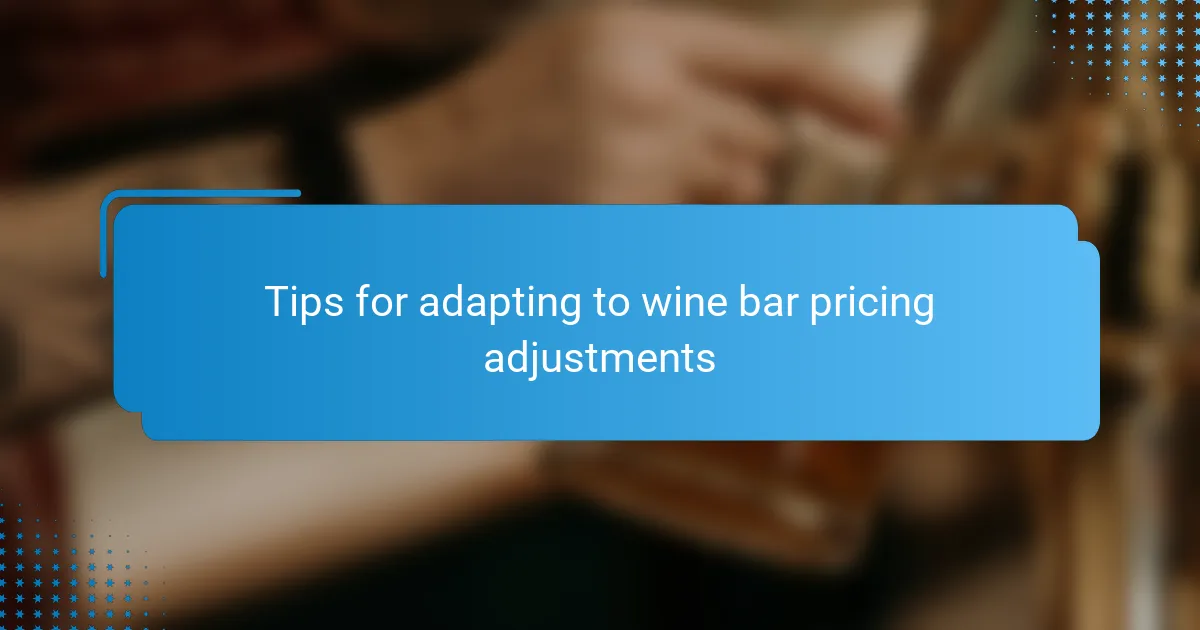
Tips for adapting to wine bar pricing adjustments
Adapting to price changes at a wine bar like The Old Vine starts with keeping an open mind—have you ever felt hesitant to order your usual simply because of a few extra dollars? I’ve learned that shifting my focus to explore new wines not only eases that sting but often turns the visit into a fun little adventure.
Another tip I’d share is to time your visits thoughtfully. Over time, I noticed that weekdays or earlier evenings sometimes bring subtle price breaks or specials, making it easier to enjoy a quality glass without stretching the budget. Have you ever caught a happy hour or a quiet time offer that made a real difference?
Also, don’t hesitate to chat with the staff about what’s behind the price adjustments. I found that asking questions not only deepened my appreciation for the wines but sometimes opened doors to unique recommendations or less obvious deals. It feels good to connect and makes the whole experience richer than just looking at numbers on a menu.
